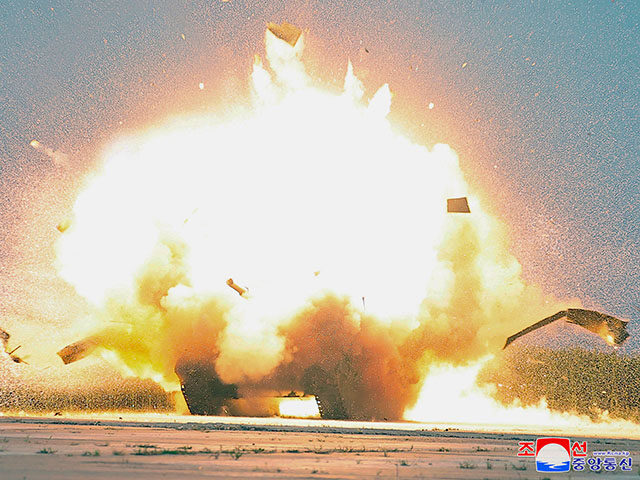North Korea revealed its first allegedly indigenous suicide drones and other combat vehicles on Monday in an article on communist dictator Kim Jong-un attending a drone performance test this weekend.
Kim emphasized that, for Pyongyang, “it is necessary to develop and produce more suicide drones of various types to be used in tactical infantry and special operation units,” according to the state-run Korean Central News Agency (KCNA).
Suicide drones, also known as loitering munitions, are explosives-carrying unmanned aerial vehicles (UAVs) that work by identifying a target and flying into it, detonating its payload. The most high-profile model of suicide drone currently in use is the Iranian “Shahed” class of drones, which Ukraine has accused Russia of deploying on its territory and Tehran itself unsuccessfully used to target Israel in April. The appeal of such drones is their relatively inexpensive manufacturing process, even compared to the famously cheap Bayraktar Turkish drone that Ukraine has incorporated into its anti-Russia efforts.
KCNA reported on Monday that Kim considers the development and mass manufacture of suicide drones a critical part of the defense of the nation from any potential South Korean or American attack. The outlet offered few details on what kinds of UAVs were present at the event the dictator attended, except to claim that all drone tests were successful.
“The drones of various types correctly identified and destroyed the designated targets after flying along different preset routes,” KCNA claimed, “Officials, scientists and researchers of the Drone Institute under the Academy of Defence Sciences were filled with surging emotion, looking up at him [Kim Jong-un] who personally oversaw the test on the spot.”
In addition to calling for significantly more investment in suicide drone development, Kim referred to another alleged weapon in his arsenal that state media revealed in January, the “underwater nuclear weapon system.”
“Calling for constantly developing not only underwater strategic weapon systems like a nuclear torpedo but also various types of unmanned underwater suicide attack craft,” KCNA reported, referring to Kim’s statements, “and opting for proactively introducing artificial intelligence technology into the development of drones, he specified the tasks and ways to this end.”
KCNA published photos allegedly showing the combat drones, white flying machines that matched the all-white outfits Kim and other communist officials wore in the propaganda shots. The photos blurred the bodies of the alleged suicide drones to hide design details, presumably for security reasons.
The South Korean newspaper Korea JoongAng Daily reported that these were the first-ever alleged suicide drones that the Kim regime claimed to possess, an apparent move to join what has become an international military trend. South Korean officials described increasing drone development as a “key component” of North Korean strategy in the near future.
“Analysts have pointed out similarities between these North Korean drones and Russia’s Lancet-3, Iran’s Shahed and Israel’s Hero 30 and IAI Harop drones, all of which are loitering munitions designed for anti-tank or long-range missions,” JoongAng observed.
The resemblance to Russian drones has led some observers to suggest that Moscow may be sharing military technology intelligence with Pyongyang. Kim and Russian strongman Vladimir Putin have increased the frequency of their in-person encounters in the past year. The most recently occurred in June, when Putin traveled to Pyongyang for the first time in over two decades.
In September, however, Kim took his train into eastern Russia, meeting Putin and senior military officials there. Upon his departure, Kim received a cornucopia of Russian gifts including “five kamikaze drones and a ‘Geran-25’ reconnaissance drone with vertical takeoff,” according to the Russian news agency Tass. The Russian government vehemently denied that the gift was a violation of United Nations sanctions on North Korea, though Moscow also aggressively opposes those sanctions.
“There have been past exchanges between North Korea and Russia involving the gifting [of drones],” Lee Chang-hyun, a spokesperson for South Korea’s Joint Chiefs of Staff, reminded reporters on Monday. “But further analysis is needed to determine if these [drones] have been upgraded or modified for use.”
During their last encounter in Pyongyang in June, Putin and Kim signed a “comprehensive” military agreement that requires each country to come to the defense of the other if attacked, reverting to past treaty agreements during the Soviet era. The document alarmed some observers in Europe who worried that North Korea could interpret Ukrainian attempts to end the ongoing full-scale invasion of the country as an attack on Russia for purposes of the treaty, necessitating North Korean involvement in the war.
Ukrainian leaders escalated that threat by directly invading undisputed Russian territory on August 6, catching the Russian government by surprised. Russia responded on Monday with one of the most pervasive attacked on the Ukrainian power grid since the full-scale invasion began. In an address on the attack, Zelensky suggested North Korea is already involved in the war.
“Defenders of life should face no restrictions on weapons, while Russia uses all kinds of its own weapons, as well as ‘Shahed’ drones and ballistic missiles from North Korea,” Zelensky said, urging allies to allow Ukraine to indiscriminately target Russia. “The United States, the United Kingdom, France, and other partners have the power to help us stop terror. We need decisions.”
Shortly before the revelation of the alleged new drones, KCNA published a screed on Saturday condemning the North Atlantic Treaty Organization (NATO) for allegedly inciting the Ukrainian counter-invasion of Russia and threatening North Korea and allied China.
“The 75-year history of NATO, stained with merciless massacre and war records, goes to prove that it is a criminal group of heinous hegemonic forces obsessed with the ambition for domination over the whole,” the North Korean state outlet, citing an alleged regime “white paper,” declared. “The present Ukrainian crisis is the latest instance eloquently proving the unchangeable sinister intention of NATO to dominate the world and hold global supremacy.”

COMMENTS
Please let us know if you're having issues with commenting.